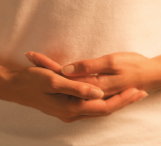MEDITATION MUDRA
This yogic hand position is thought to make you receptive to the input of inspirational energy from the world around you. Place your left hand on top of your right hand at waist level with your palms facing upward.

“Blessed is the person who can breathe through his bones.”
Indian proverb
Whether you enjoy a brisk morning walk or a leisurely stroll after dinner, a daily outing on foot connects you with the energy of your expansive vyana breath. Moving around expands your world-view – one of the qualities of this breath – while walking conditions your heart and lungs, alleviates stress, stimulates digestion and encourages elimination, including the efficient expelling of stale air from your lungs. Observing your breath as you walk also helps to clear the mind of mental chatter.
Being clumsy or accident-prone may be an indication that you are not fully connecting with your breath. A separation between your mind, body and breath may leave you feeling ungrounded, out of balance, spaced out or emotionally numb. It may also be an indication that you spend too much time “in your head” rather than expanding your energies to connect with those around you – a sign of depleted vyana energy. To reconnect with this breath, make time to walk most days, if possible barefoot over grass or on a beach, and try to practise the Meditative Breath Walking exercise, opposite.
Or try this variation: start with your hands relaxed by your sides. Begin walking at normal pace and gradually lengthen your stride. Taking larger steps causes your arms to swing out further, accelerating your pace.
This yogic hand position is thought to make you receptive to the input of inspirational energy from the world around you. Place your left hand on top of your right hand at waist level with your palms facing upward.

Choose a peaceful spot outdoors for this moving breathing exercise, and practise with bare feet whenever possible.
1 First ground yourself: stand with your feet hip-width apart and parallel to each other with your arms relaxed by your sides. Close your eyes and gently seal your lips. Firmly press both feet into the ground and spread your body weight evenly over them, visualizing a connection with the earth beneath you. Lift your toes and spread them as you replace them on the ground. Hold this pose for a minute or two as you take some deep breaths through your nose.
2 When you feel ready, slowly open your eyes halfway. Fix your gaze on the ground approximately ½m (2½ft) in front of you. Place your hands in Meditation Mudra (see opposite, below).
3 Begin to walk, taking slow, short steps. Step forward with your right foot by about 15cm (6in), then take a moment to ground yourself before stepping your left foot forward by the same amount, grounding yourself again. Continue to walk with awareness in this way.
4 Tune each step with your breath: inhale as you lift your foot and exhale as you place it back on the ground. Notice how, after a while, your walking develops a natural rhythm.
5 As you walk, consciously keep your weight balanced over the centre of your body; do not allow it to shift forward or hang back. As your foot touches the ground, feel it rooting itself deeply.
6 Observe how your body becomes involved in the walking action. See how each knee bends, lifts and straightens. Be aware of the movement in your ankles, hips, spine and shoulders. When your attention wanders, keep bringing it back to your breath. Practise for as long as feels right before relaxing and returning to your regular activity.